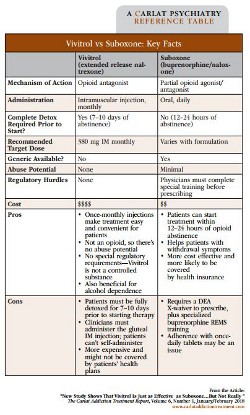New Study Shows That Vivitrol Is Just as Effective as Suboxone…But Not Really
The Carlat Addiction Treatment Report, Volume 6, Number 1, January 2018
https://www.thecarlatreport.com/newsletter-issue/catrv6n1/
Issue Links: Learning Objectives | Editorial Information | PDF of Issue
Topics: Addiction
A recent study in The Lancet appears to conclude that Vivitrol (extended release naltrexone) and Suboxone (buprenorphine/naloxone) are equally effective treatments for patients with opioid use disorders (Lee JD et al, The Lancet 2018;391(10118):309–318)—at least this is how the study has generally been reported. But a deeper dive into the study reveals some nuances to the results that are crucial to understand before you decide which treatment is best for your patients.
In the multi-site open-label study, which was funded by NIDA (the National Institute on Drug Abuse), 570 adults with opioid use disorder were recruited from eight large U.S. community treatment programs. Most participants were unemployed white men on Medicaid, ages 25–45, and were primarily heroin users. All of them were undergoing or had completed inpatient opioid detox protocols at the time of recruitment. Participants were randomly assigned to either monthly Vivitrol injections (n = 283) or daily Suboxone sublingual films (n = 287). Before receiving their first Vivitrol injection, patients had to have opioid-negative urine and a negative naloxone challenge (meaning no withdrawal symptoms after an intramuscular dose of naloxone); thereafter, they received injections monthly. Patients assigned to Suboxone were induced in the usual way (see CATR January 2015 for details on induction), were seen weekly or every other week in the clinic, and took their doses as outpatients. All patients were followed for 24 weeks, or to their relapse, whichever came sooner. The primary outcome was time to relapse, defined as 7 consecutive days of non-prescribed opioid use.
How did the groups compare in terms of relapse? It depends on which patients you look at. If you focus on only those patients who successfully completed each treatment, relapse rates were about the same—52% with Vivitrol and 55.6% with Suboxone. However, if you analyze the entire population (a so-called intent-to-treat analysis), Suboxone was more effective than Vivitrol, with a statistically lower relapse rate of 57% vs Vivitrol’s 65%. The reason for the difference is that more Vivitrol patients dropped out of detox—28% of patients (79 of 283) dropped out before the first Vivitrol injection, while only 6% of patients (17 of 287) dropped out before Suboxone induction.
Why is Vivitrol detox so hard to tolerate? It’s because patients must be opiate-free for at least a week before receiving Vivitrol, and this is a high hurdle for many addicted patients. Suboxone induction is much easier, since when opiate withdrawal signs are moderate, patients are allowed to take their first Suboxone doses.
The bottom line is that for patients who are actively using, Suboxone is still generally the most effective treatment. Suboxone formulations are less expensive, and they work during withdrawal.
You might, though, consider Vivitrol for patients who meet the following criteria:
- Have already been opiate-free for at least a week
- Have had no success with agonist treatments
- Prefer to not take agonist treatments, or cannot do so because of legal or job requirements
- Live in an area where there are no physicians qualified to provide Suboxone
- Have a milder addiction and are highly motivated to quit
- Have difficulty committing to taking a medication every day
Ultimately, the decision of using Suboxone vs Vivitrol is a judgment call to be made in conversation with your patients. See the table on page 2 for quick reference facts about each treatment, as well as pros and cons to help you make the right decision.



